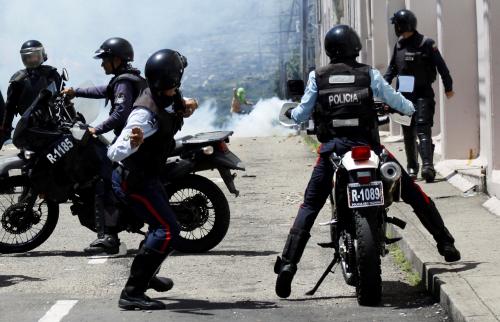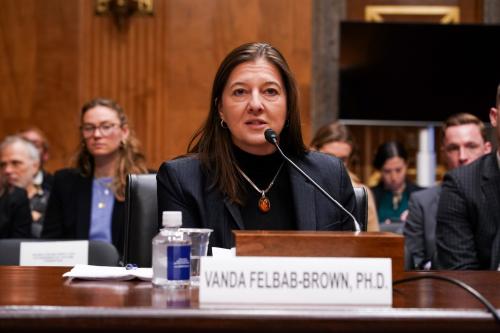Crime and violence are a serious problem in Latin America. Brazil, for example, had 61,000 homicides in 2016, a frequency nearing that of countries in conflict.
Places where crime is prevented one way or the other are those where catching an offender is easier. The control function begins with an arrest by the police, but is subsequently the domain of the judicial branch, which must investigate and prosecute offenders. According to a 2017 Global Impunity Index, the capacity of the judiciary to deliver sanctions is in a critical condition in Latin America. The organization of the judiciary and the specific processes involved in investigation and prosecution matter a lot for the system’s effectiveness. Institutional reforms that change core processes in the public sector are rare, but even rarer are rigorous evaluations of the impact of the reform. A new study of the homicide investigation process led by Colombia’s Office of the Attorney General did exactly this.
The Colombian experiment
The outcome of the investigative process depends on the capacity to collect, preserve, process and analyze the relevant material to credibly conclude whether a crime was committed, and attribute criminal responsibility. Colombia’s traditional process had fragmented investigative duties, and changing leadership during different stages of the judicial procedure. The proposed change assigned a team of investigators, police officers, and district attorneys to each case, all the way until the submission of an indictment bill before a court. Streamlining and stability were expected to improve the quality of the investigation by preserving relevant information, improved communication among team members, and promoting accountability.
For the purposes of the evaluation, crime scene investigators and judicial police teams were divided into six groups, with four assigned to treatment via a simple lottery. Each group was assigned to cover all incidents in a 12-hour shift. The groups’ rotation throughout the month meant that each group covered every one of the possible 14 weekly shifts at least once every 6 weeks (2.3 shifts per week). The experiment lasted 42 weeks, with each shift covered approximately seven times per team. By construction, this scheme randomly assigned cases across treatment and control teams, which implies that observed investigation and judicial outcome differences, can be attributed to the new policy, and not to systematic differences between cases. The structure of the traditional and experimental procedures is shown in Figure 2.
Figure 2. Description of the experiment and traditional versus new procedure
What we found
Over the study period (January 20 to December 4, 2016), there were 1,683 homicide cases in Bogotá, with 1,110 (about two-thirds) assigned to the new investigation scheme and the remaining one third to the standard procedure. The experimental design meant that comparing cases assigned to one track versus another measured the causal effect of the new procedure on various indicators of investigative efficiency. We measured differences in specific actions undertaken by investigative teams, the outcomes of those actions, and investigators’ perceptions about the process. The first two relied on the administrative database from the Office of the Attorney General’s internal case control system (known as SPOA) and the last one on a survey of investigative teams and district attorneys.
The new structure improved relevant initial investigation outcomes. The minimum necessary investigative actions and forensic tests and procedures increased from 12 percent to 27 percent of 1 standard deviation of the control group, depending on the exact measure used. This meant more thorough inspections of the crime scene, better collection of material evidence, and more informative interviews of witnesses. The treatment group took seventeen more days to produce an indictment, but this did not delay the indictment bill. A thorough initial analysis takes more time but increases the quality of the indictment, which moves faster to the indictment bill stage.
Extension requests fell by 15 percent of a standard deviation of the control group. When “young” cases (that mechanically have a low probability of having advanced through the process) are excluded, the bill of indictment rate for new stable investigative teams is 46 percent of a standard deviation higher than in traditional teams. Preliminary analysis of the data almost two years after the experimental period ended, suggests clearance rates in the experimental group were 17.4 percent higher in the treatment than in the control group.
Although somewhat tentative due to the small sample size, the survey data complement the previous results by suggesting an improvement in the relationship between officials. The new policy seems to have improved motivation, prompted better feedback on performance, the pertinence and effectiveness of team members, and the quality of teamwork. Treatment investigators also report a lower incidence of efficiency problems and information loss.
What we learned
Stable membership of criminal investigative teams seems to be an important factor in the quality of a homicide investigation. It helps avoid communication problems, information loss, and leadership fragmentation. In the Bogotá experiment led by Colombia’s Prosecution and Investigation Office, we saw improvements in intermediate indicators and team members’ perceptions. Most importantly, we saw better judicial outcomes.
Well-functioning bureaucracies are needed for effective provision of public goods and services. Proper diagnoses of the organizational architecture of public institutions, and the implementation of innovative solutions to bottlenecks or inefficiencies, can bring big improvements in the criminal justice system. Our study of the experience of the homicide investigation process in the Colombian Attorney General’s office shows that an impact evaluation is both possible and useful.







Commentary
A new way to investigate homicides in Colombia
November 8, 2018